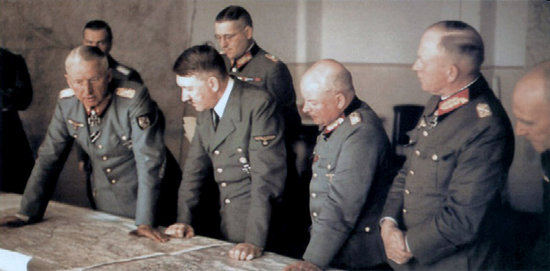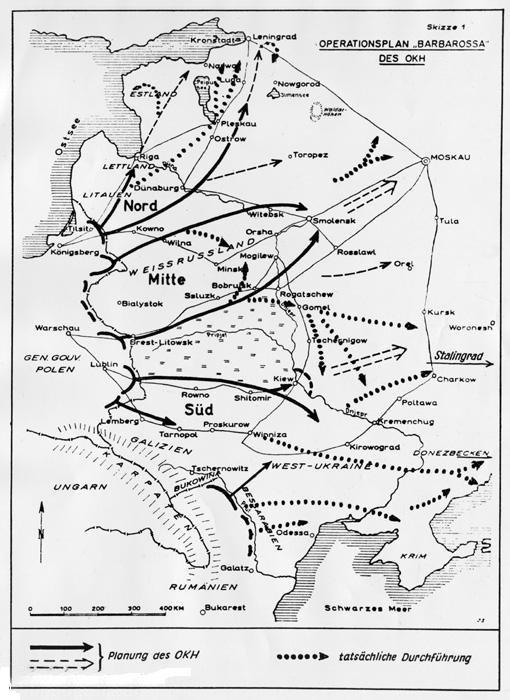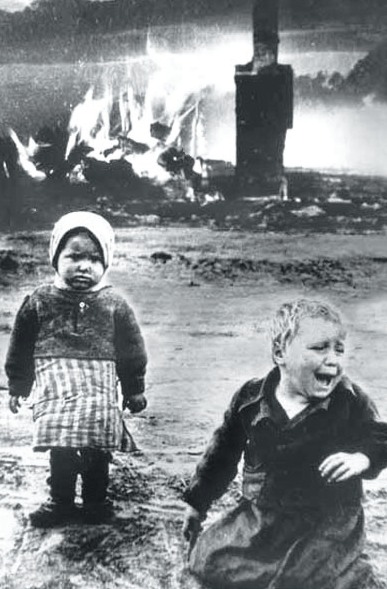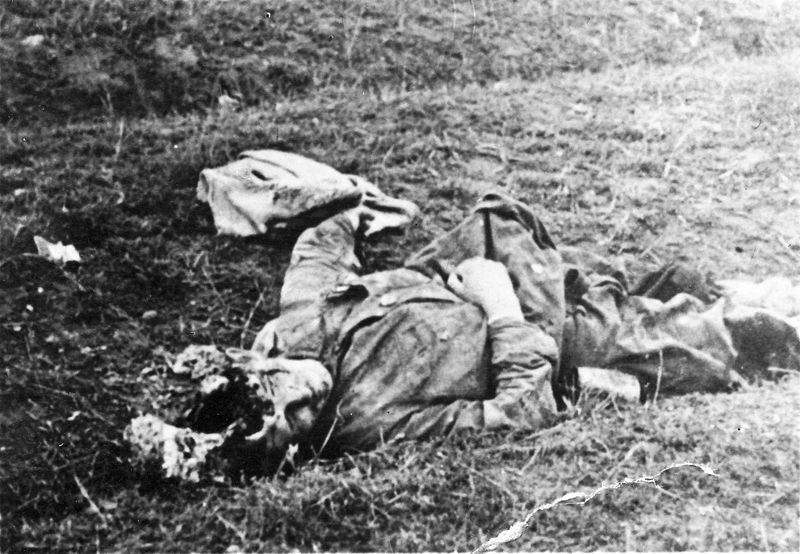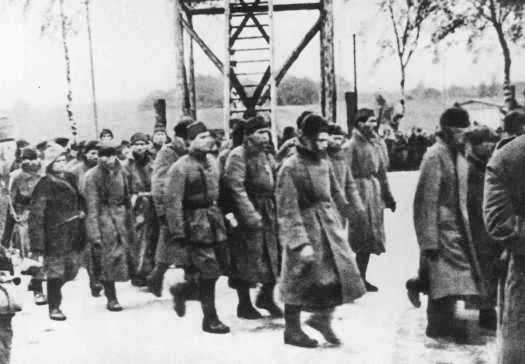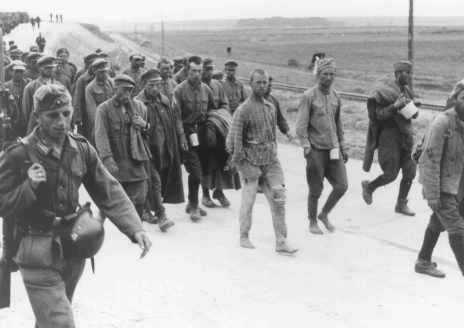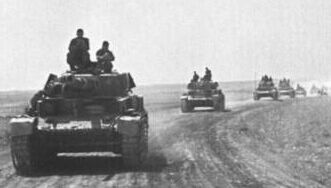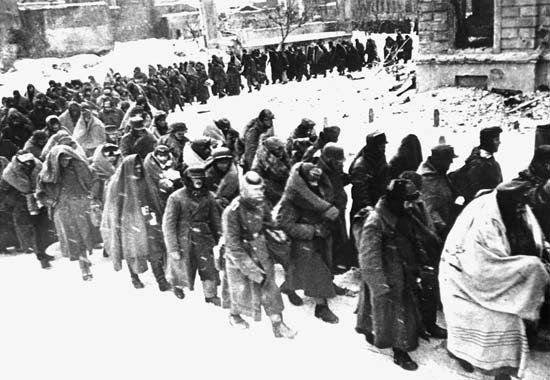Holocaust Education & Archive Research Team |
|
Occupation German Occupation of Europe Timeline
-
[The Occupied Nations]
Poland Austria Belgium Bulgaria Denmark France Germany Greece Hungary Italy Luxembourg The Netherlands Norway Romania Slovakia Soviet Union Sudetenland | |||||||||||||||||||||||||||||||||||||||||
The Occupation of the Soviet Union
Brief Military Overview & Impact on Soviet Prisoners of War and Civilians
Adolf Hitler had decided to attack the Soviet Union as early as July 1940, directly after the victory over the French, and Allied Forces, but for once he listened to the objections of his Generals and decided to delay the invasion, due to concerns over the weather and the need to build up the Wehrmacht and Luftwaffe forces.
Hitler’s decision to attack the Soviet Union under the title of Barbarossa, named after Emperor Frederick Barbarossa, one of the heroes of German history, who at the close of the 12th century marched with his knights against the infidel in the Holy Land, was designed to give the German people “Lebensraum” – Living Space.
The German General Staff submitted various plans but Hitler’s variant – Barbarossa in December 1940 was the plan that was put into action. His plan envisaged the weight of the invasion was now decisively shifted to the North.
Leningrad became the main military target and Moscow was to be taken afterwards, while the operations in the South were initially confined to the occupation of the Ukraine West of Kiev.
All the variants proposed had the gigantic intention of destroying the Red Army in huge battlements of encirclement in the Baltic States, Belorussia and the Ukraine, to prevent the Soviet forces escaping into the interior of Russia.
The German and Axis forces that invaded the Soviet Union were split into three Army Groups:
Shortly after 0300 hours on the 22 June 1941 the whole of the German front line from the Carpathians to the Baltic moved forward after a short artillery bombardment across the demarcation line, while Luftwaffe squadrons above them flew far into Russia, facing them were 4 Russian Military Districts, as follows:
The German forces in the initial stages benefited from Stalin’s reluctance to believe that Hitler would invade Russia, given the non-aggression pact they had signed in 1939, and the Russians seemed taken by surprise.
The German blitzkrieg advanced very quickly into the Soviet Union, over 100km a day, sweeping all before them, 8 Russian Divisions were virtually annihilated on the first day alone. During the first two days over 2000 Russian planes were destroyed by the Luftwaffe, most of them on the ground.
In a week the Wehrmacht had advanced half way to Moscow and in a month had conquered territory double the size of the Reich. Russian and Baltic States cities fell in quick succession to the relentless German attacks, such as Brest- Litovsk, Vitebsk, Smolensk, Zhitomir, Riga, Kovno and Vilna. Leningrad was surrounded and the siege lasted until late 1943, but the city was never captured, but cost thousands of lives.
The Germans were welcomed in part by some locals in the Baltic States where the Germans were seen as liberators, some of these locals dreamed of self-determination, but quickly found the Nazis unwilling to be that accommodating.
However, some did not welcome the Nazis with open hands, and with good cause not to, behind the front lines roamed the Einsatzgruppen, A, B, C and D whose task was to murder Jews, Communists, Political Commissars and Gypsies. The mass murder was mainly carried out by shooting, but gas vans were used in certain locations.
Hitler saw the war against the Bolsheviks as a fundamental clash of political systems, and he waged this war with utter ruthlessness. This will be covered in more detail in separate article outlining the role of the SS and SD in Russia, and how Hitler viewed the war with the Soviets, particularly in relation to the extermination of Soviet Jewry and Political Commissars.
As the cities fell, the Germans captured vast numbers of Soviet troops often in sweeping pincer movements such as in the Uman pocket, and in the Minsk pocket.
A million Soviet troops were captured in the first month of the invasion, and millions of POW’s died in captivity, often in the most barbarous circumstances. They were held in primitive prisoner –of – war camps such as in Chelm in Poland, and in concentration camps such as Auschwitz and Majdanek but over time could be found in the majority of concentration camps.
The first mass gassing in Auschwitz was carried out on Soviet Prisoners –of War during August 1941 in the cellar of Block XI by Karl Fritzsch, the deputy commandant, using Zyklon B.
Six hundred invalid Russian prisoners-of –war together with two-hundred and fifty inmates of the Auschwitz infirmary were locked in the infamous penal block in the main camp. The windows were earthed in, and the Zyklon B crystals were simply thrown through the door. But on the following afternoon when SS- Haputscharfuhrer Palitzsch entered the cellar many living bodies were discovered and the whole process had to be repeated.
On the 12 August 1941 Hitler orders the Panzers South to the Ukraine to eliminate the Soviet South – West Front, instead of advancing on Moscow, against the advice of his Generals.
The victory by the Germans in the Kiev cauldron was seen as the greatest military catastrophe for the Soviets, in their history, with over half a million Soviet soldiers either dead or captured.
The Germans occupied Kiev on the 19 September 1941 and five days later a huge explosion wrecked the Continental Hotel, the headquarters of the Rear Area Command of the VI Army.
The fires spread rapidly, twenty –five thousand people were made homeless and hundreds of German troops died in fighting the fires. At a conference between Jeckeln, SSPF Russland- Sud, Dr Otto Rasch of the Einsaztgruppe and Eberhardt, the town commandant it was decided that the Jews would be treated as reprisal victims.
What followed was one of the greatest single mass murder actions in history, 33,771 Jews were killed over two days on the 29 September and 30 September 1941, in the Babi Yar ravine.
Standartenfuhrer Paul Blobel was in charge of the Einsatzgruppen shooting squads, who carried out the massacre, the victims received a shot in the neck as they stepped from a plank into the ravine.
The Kiev massacre must go down in history as the most remembered atrocity in the German extermination of Soviet Jewry.
With Kiev captured on the 26 September 1941 Hitler ordered the assault on Moscow, “Operation Typhoon”, the Germans intended to pounce on Moscow like a hurricane and seize it. The offensive began in ideal weather conditions on the 2 October, and things looked promising for the German invaders.
“Operation Typhoon” claimed stunning victories in the Vyazma and Bryansk pockets on the 7 October and the following day the skies opened up and heavy rain fell. Thus began the “season of the mud,” which considerably slowed down the German advance.
After the mud the first snows fell around the 10 October and it quickly became apparent to the General’s in the field that the troops lacked adequate winter clothing, but official requests for winter clothing were ignored
“We were quite happy about the success of the German Armies in Russia and the first inkling that something is wrong was when Goebbels made a big action in the whole of Germany to collect furs and winter clothes for the German troops, and then we knew that something was happening that was not foreseen.”
Stalin appointed Marshall Zhukov who had commanded the defence of Leningrad with great skill, to lead the defence of Moscow. Forty divisions of Siberian troops were also moved from the Siberian front, to bolster up the Soviet forces. A State of Emergency for Moscow and the adjacent regions was declared from the 20 October 1941.
The Germans continued to advance on Moscow but by mid-November 1941 the advance was halted by 20 degree of frost and desperate Russian resistance.
The Panzers continued to roll and reached the village of Krasnaya Polyana at the end of November, a mere 18 miles from Moscow. In the centre of the front they had reached the village of Burtsevo, 25 miles from Moscow, Kashira 69 miles from the capital.
In the central sector on the 4 December 1941 the Army Group Centre continues its advance on Moscow, particularly in the area of Tula, South of the capital. But the next night brings the great frost thirty five degrees below zero.
The tanks will not start, the guns will not fire and thousands of men suffer from frostbite. The following day the 5 December the German offensive stalls in front of Moscow, due to lack of equipment combined with the terrible winter conditions and the Russians launch a general counter- offensive all along the front, especially on the Moscow front.
By the 11 December 1941 the Russians announce the liberation of 400 places in the Moscow area and the destruction of 17 German divisions, including seven armoured and three motorised divisions. Hitler announces the end of the winter campaign against Russia, Operation Barbarossa has ended in failure.
On the 20 December 1941 Josef Goebbels, the Nazi Propaganda Minister makes a broadcast an appeal for warm clothing for German soldiers serving in Russia.
Albert Speer recalled:
“We were quite happy about the success of the German Armies in Russia and the first inkling that something is wrong was when Goebbels made a big action in the whole of Germany to collect furs and winter clothes for the German troops, and then we knew that something was happening that was not foreseen.”
Despite being regarded as the Untermensch (Sub-human) the Germans waived all such notions when it came to robbing the Jews of the General Gouvernment of their furs, to keep the Wehrmacht warm on the Russian front during the severe winter, whilst they froze in the harsh Polish winters.
Adam Czerniakow the Chairman of the Warsaw Ghetto made this entry on the 24 December 1941:
“I received a message from Warsaw that – according to an edict – we must surrender all the furs – both men’s and women’s. I am to be personally responsible. The deadline has been set for December 28, 1941.”
This will be covered in a separate article.
Sources:
History of the Second World War published by Purnell & Sons 1966. The World at War by Richard Holmes published by Ebury Press 2007. The Field Men by French L MacLean published by Schiffer Military History Atglen PA 1999. The Final Solution by G.Reitlinger published by Sphere Books Ltd 1971. The Warsaw Diary of Adam Czerniakow published by Elephant Paperbacks Chicago 1999. IMT Nuremberg Trial Archives Holocaust Historical Society * Thanks to Frederick John Webb
Copyright: Chris Webb H.E.A.R.T 2008
|
